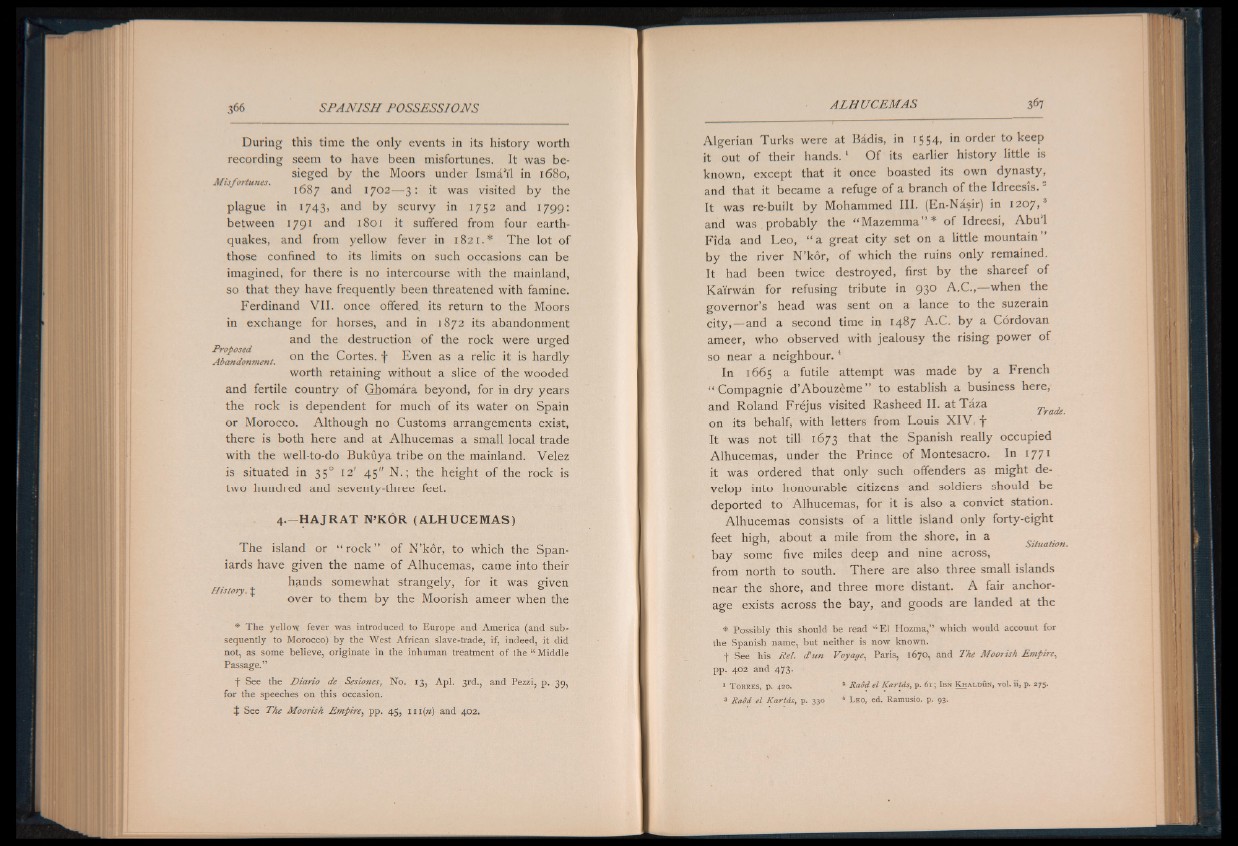
During this time the only events in its history worth
recording seem to have been misfortunes. It was besieged
by the Moors under Ismá*íl in 1680,
Misfortunes. , , . . . . .
1687 and 1702— 3: it was visited by the
plague in 1743, and by scurvy in 1752 and 1799:
between 1791 and 1801 it suffered from four earthquakes,
and from yellow fever in 1821.* The lot of
those confined to its limits on such occasions can be
imagined, for there is no intercourse with the mainland,
so that they have frequently been threatened with famine.
Ferdinand VII. once offered, its return to the Moors
in exchange for horses, and in 1872 its abandonment
and the destruction of the rock were urged
PAbindonment. on the Cortes. f Even as a relic it is hardly
worth retaining without a slice of the wooded
and fertile country of Ghomára beyond, for in dry years
the rock is dependent for much of its water on Spain
or Morocco. Although no Customs arrangements exist,
there is both here and at Alhucemas a small local trade
with the well-to-do Buküya tribe on the mainland. Velez
is situated in 350 12' 45" N . ; the height of the rock is
two hundred and seventy-three feet.
4.—HAJRAT N’KÓR (ALHUCEMAS)
The island or “ rock ” of N’kór, to which the Spaniards
have given the name of Alhucemas, came into their
hands somewhat strangely, for it was given
over to them by the Moorish ameer when the
^ The yellow fever was introduced to Europe and America (and subsequently
to Morocco) by the West African slave-trade, if, indeed, it did
not, as some believe, originate in the inhuman treatment of the iC Middle
Passage.”
f See the Diario de Sesiones, No. 13, Api. 3rd., and Pezzi, p. 39,
for the speeches on this occasion.
J See The Moorish Empire, pp. 45, I I I (n) and 402.
Algerian Turks were at Badis, in 1554, in order to keep
it out of their hands.1 O f its earlier history little is
known, except that it once boasted its own dynasty,
and that it became a refuge of a branch of the Idreesls.5
It was re-built by Mohammed III. (En-Nasir) in 1207,’
and was probably the “ Mazemma” * of Idreesi, Abu‘1
Fida and Leo, “ a great city set on a little mountain ”
by the river N’kor, of which the ruins only remained.
It had been twice destroyed, first by the shareef of
Kairwan for refusing tribute in 930 A.C.,— when the
governor’s head was sent on a lance to the suzerain
city,— and a second time in 1487 A.C. by a Cordovan
ameer, who observed with jealousy the rising power of
so near a neighbour.4
In 1665 a futile attempt was made by a French
“ Compagnie d’Abouzeme” to establish a business here,
and Roland Frejus visited Rasheed II. at Taza Trade
on its behalf, with letters from Louis X IV . f
It was not till 1673 that the Spanish really occupied
Alhucemas, under the Prince of Montesacro. In 1771
it was ordered that only such offenders as might develop
into honourable citizens and soldiers should be
deported to Alhucemas, for it is also a convict station.
Alhucemas consists of a little island only forty-eight
feet high, about a mile from the shore, in a situation
bay some five miles deep and nine across,
from north to south. There are also three small islands
near the shore, and three more distant. A fair anchorage
exists across the bay, and goods are landed at the
« Possibly this should be read “ El Hozma,” which would account for
the Spanish name, but neither is now known.
■(• See his Rel. d'un Voyage, Paris, 1670, and The Moorish Empire,
pp. 402 and 473.
1 T o r r e s , p . 4 20 . 1 RaSd e l Kartds, p . 6 1 ; I b n K h a l d u n ’ , v o l . i i , p . 2 7 5 .
3 Radd el Kartds, p . 3 30 * L e o , ed. R a m u s i o . p . 9 3 .